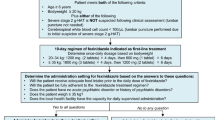Abstract.
Eflornithine is the only new molecule registered for the treatment of human African trypanosomiasis over the last 50 years. It is the drug used mainly as a back-up for melarsoprol refractory Trypanosoma brucei gambiense cases. The most commonly used dosage regimen for the treatment of T. b. gambiense sleeping sickness consists of 100 mg kg–1 body weight at intervals of 6 h for 14 days (150 mg kg–1 body weight in children) of eflornithine given as short infusions. Its efficacy against Trypanosoma brucei rhodesiense is limited due to the innate lack of susceptibility of this parasite based on a higher ornithine decarboxylase turnover. Adverse drug reactions during eflornithine therapy are frequent and the characteristics are similar to other cytotoxic drugs for the treatment of cancer. Their occurrence and intensity increase with the duration of treatment and the severity of the general condition of the patient. Generally, adverse reactions to eflornithine are reversible after the end of treatment. They include convulsions (7%), gastrointestinal symptoms like nausea, vomiting and diarrhea (10%–39%), bone marrow toxicity leading to anemia, leucopenia and thrombocytopenia (25–50%), hearing impairment (5% in cancer patients) and alopecia (5–10%). The drug arrests embryonic development in mice, rats and rabbits but the extent of excretion into breast milk is unknown. The mean half-life is around 3–4 h and the volume of distribution in the range of 0.35 l kg–1. Renal clearance is about 2 ml min kg–1 (i.v.) and accounts for more than 80% of drug elimination. Bioavailability of an orally administered 10 mg kg–1 dose was estimated at 54%. One of the major determinants of successful treatment seems to be the cerebrospinal fluid drug level reached during treatment, and it was shown that levels above 50 µmol l–1 must be reached to attain the consistent clearance of parasites. Based on its trypanostatic rather than trypanocidal mode of action, it is a rather slow-acting drug.
Similar content being viewed by others
Author information
Authors and Affiliations
Additional information
Electronic Publication
Rights and permissions
About this article
Cite this article
Burri, C., Brun, R. Eflornithine for the treatment of human African trypanosomiasis. Parasitol Res 90 (Suppl 1), S49–S52 (2003). https://doi.org/10.1007/s00436-002-0766-5
Issue Date:
DOI: https://doi.org/10.1007/s00436-002-0766-5




